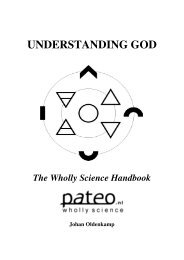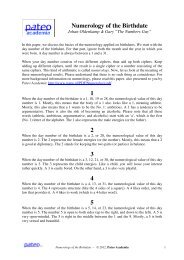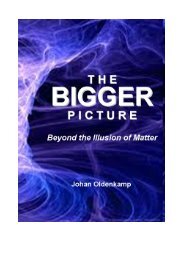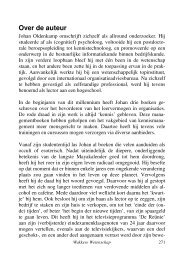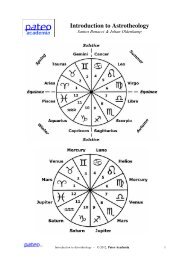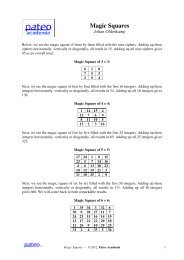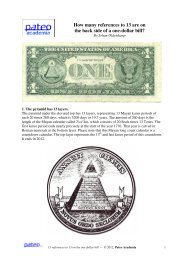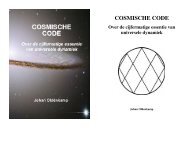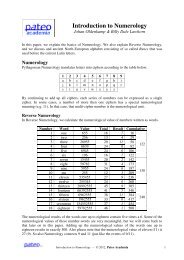WHOLLY SCIENCE - Pateo.nl
WHOLLY SCIENCE - Pateo.nl
WHOLLY SCIENCE - Pateo.nl
Create successful ePaper yourself
Turn your PDF publications into a flip-book with our unique Google optimized e-Paper software.
cles of the slower wave), both waves synchronously pass through the<br />
zero point from the same direction.<br />
The illusion of matter o<strong>nl</strong>y occurs in the nodes. This is true on each<br />
level, ranging from entities as small as subatomic particles to those<br />
as large as clusters of galaxies. The shells of electrons and the orbits<br />
of planets are nodes in a cosmic symphony of energetic waves. Let<br />
us now investigate this illusion of matter a little further.<br />
2.1 The Illusion of Matter<br />
Again, both waves have a shared null point in the middle.<br />
The figure below shows the third harmonic ratio, which is 3:4, the<br />
ratio of the quart. After four cycles of the faster wave (and three cycles<br />
of the slower wave), both waves synchronously pass through the<br />
zero point.<br />
The shared null point in the middle is also present in this third harmonic<br />
ratio.<br />
Each of these three harmonic ratios repeatingly create three nodes:<br />
one at the beginning, one in the middle, and one at the end.<br />
32<br />
Wholly Science – Understanding the Process of Creation<br />
In trying to understand what matter really is, universities started to<br />
look for the smallest building blocks of these shadows. In the quest<br />
to find these elementary pellets, university scholars first found molecules.<br />
A molecule is the smallest particle that still possesses all the<br />
characteristic features of the whole.<br />
Next, the division of molecules resulted in even smaller particles,<br />
called atoms. For instance, a water molecule consists of two hydrogen<br />
atoms and one oxygen atom.<br />
For a long time, modern science thought atoms were the most<br />
elementary units. The word atom means ‘indivisible’. This meaning<br />
however, turned out to be inappropriate, since a further division of<br />
atoms resulted in a nucleus of protons and neutrons surrounded by<br />
orbiting electrons. Later, modern science also discovered antimatter,<br />
consisting of positrons (which are anti-electrons), antiprotons and<br />
antineutrons.<br />
The journey inwards did not stop at the level of protons, neutrons<br />
and electrons. On stepping further down the road of finding the<br />
(hard) core of matter, the division of these three subatomic particles<br />
resulted in quarks. In total, modern science has identified six types<br />
Wholly Science – Understanding the Process of Creation 33





